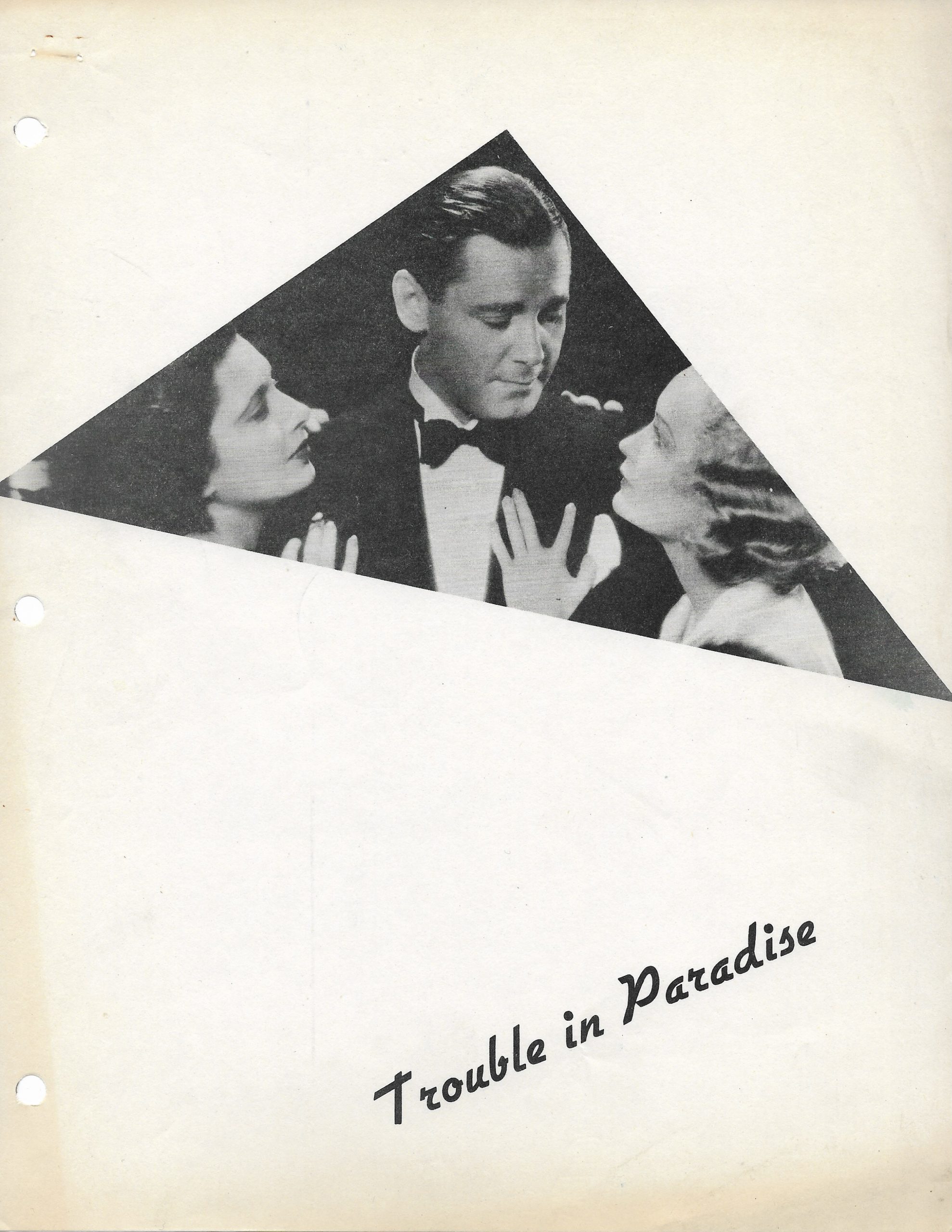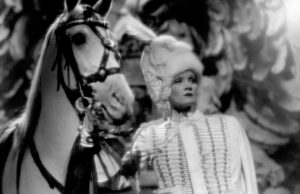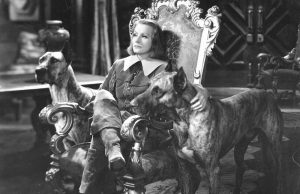Trouble in Paradise (1932)

Toronto Film Society presented Trouble in Paradise (1932) on Monday, February 9, 1953 as part of the Season 5 Main Series, Programme 6.
SIXTH EXHIBITION MEETING – FIFTH SEASON
Monday, February 9, 1953 Doors close 8.15 p.m.
Royal Ontario Museum Theatre

The Seventh Age Denmark 1947 16 mins
DIRECTION: Torben Svendsen
SCRIPT: Carl Theodor Dreyer
PHOTOGRAPHY: Karl Andersson
MUSIC: Emil Reesen
ENGLISH COMMENTATORS: Ralph Elton and Susanne Palsbo
“Denmark came out of the war with a tough and lusty school of documentary. Its films have been admired for their technical virtuosity, their humanity, and their humour. Film after film, particularly those tackling propaganda themes, has a neat and witty script, and imaginative presentation.” So wrote Arthur Elton in 1948 when he was Advisor on documentary film to Denmark. It is only recently that a few of these films have filtered into Canada, and it is hoped that the Society will be able to present further examples from this now established school of documentary.
The Seventh Age, a film on the care of aged people is the fifth in a series dealing with Danish Social Services–a series designed both for internal information, and more particularly, for overseas use. The script by Dreyer (Passion of Joan of Arc and Day of Wrath) is notable for its sincerity and simplicity, both of which have ben admirably translated to the screen by the director. The film is factual in the sense that it gives a clear exposition of the old age pension system and the numerous homes for the care of old people which are maintained by Danish communities. But it is also human. The problems of old age are shown through the eyes and persons of aged folk of all sorts. They are by turn pathetic, humorous, vigorous, astonishing and charming; some of them are almost repulsive–for this is one of old age’s greatest tragedies. The problems are fairly and clearly stated, and there is no attempt to gloss over what the Danes themselves regard as inadequacies. At one point, for instance, a fine Home for aged people is deliberately emphasised by the phrase “not typical.” (Basil Wright)
The Champion USA 1915 25 mins at 18.18 f.p.s.
WRITTEN and DIRECTED by Charles Chaplin
PHOTOGRAPHED by Rollie Totheroh
CAST: Bud Jamison, Edna Purviance, Leo White, Ben Turpin, Lloyd Bacon, and “Broncho Billy” Anderson (playing an extra in the stands)
The 14 Chaplin-Essanay films made during 1915 were a transition from the Keystone charades to the polished Mutual series of 1916-17. Though Chaplin has never forgotten, nor entirely abandoned the lessons in slapstick and cinematic comedy he learned from Mack Sennett, by 1915 he was creatively pretty much on his own. His earlier films had ben shot in a day or two, or a week at most, and improvised on the spot; now he took more time and care. And though Chaplin never used a shooting script until the sound era, preferring to improvise from a rough outline, the Essanays are well-constructed, have a more developed plot and show more restraint than is previous efforts.
The Chaplin gag perhaps was an accommodation to his short stature. This called for the use of his wits in encounters with giants–like David and Goliath. It was a clever trick or comic stunt, not necessarily “legitimate,” invented to overcome superior force. Thus, in The Champion before getting a job as a sparring partner, Charlie picks up a horseshoe, the symbol of good luck–and makes sure of the luck by slipping it inside his boxing glove. (Theodore Huff)
INTERMISSION
10 minutes
ERNST LUBITSCH (1892-1947)
In Germany, between 1914 and 1922, Ernst Lubitsch acted in and directed slapstick comedies, farces and historical drama; in America, from 1923 to the end of the silent era, he directed dramas, drawing room comedies and topical films. This protean achievement, the most versatile on record, covers the whole range of film genres except the epic. Yet even such astonishing versatility would not have given his work so wide an appeal had it not been for his quasi-Shakespearian concern with people, the multi-colored characters who populate and quicken his films. They are a raffish lot and he has delineated them with an acidity that makes them as real to us as our closest friends. He has subordinated everything to them, frequently even the stories of his films. In a Lubitsch film, the play is not the thing–it is but a device wherewith he can reveal people to us–their petty bickerings, their foibles and weaknesses, vanities, desires, dreams, disillusionments, in the “human-all-too-human” comedy of life. But perhaps it is as a farceur that he is best known. Most of the time he is content not to scratch the surface of his characters too deeply but just to show us how thin the veneer of their “respectability” usually is. After that, he lets them go with a wink or a leer, and we laugh with him, recognizing these all-too-familiar traits in ourselves. It is all good-natured fun and the world is at least that much better off for having had it.
Critics have marked his blending of Gallic zest with Attic wit, albeit it would seem that the cultures of Gaul and Hellas are not the wellsprings of his inspiration so much as a considerably more latter-day Hungary and the Balkans. Lubitsch (a Balkan name, incidentally) employs a Central European harshness and irony of attack in achieving his effects–it is the repartee of the cafés and clubs, as in that exclusive Budapest club with its sign, “Members may not bring their mistresses as guests unless they are the wives of other members.”
Touché!
“Lubitsch touch!”
Museum of Modern Art
Herman G. Weinberg
Trouble in Paradise (1932)
DIRECTED and PRODUCED by Ernst Lubitsch
SCREEN PLAY by Samson Raphaelson
ADAPTED by Grover Jones
from the play, “The Honest Finder” by Lszlo Aladar
PHOTOGRAPHED by Victor Milner
SETS by Hans Dreier
MUSIC by W. Franke Harling
CAST: Herbert Marshall (Gaston Monescu, alias Gaston Laval, alias the Baron), Miriam Hopkins (Lily, alias the Countess), Kay Francis (Mariette Colet), Edward Everett Horton (François), Charlie Ruggles (The Major), C. Aubrey Smith (Adolf J. Giron), Robert Craig (Jacques, the manservant), Leonid Kinskey (A Russian).

Arriving in Hollywood in 1922, after 13 years in the movies in Germany, Lubitsch directed a series of films of such sophistication, wit and cinematic brilliance that he became the dominating figure in Hollywood. His silent social comedies made between 1923 and 1926 playfully satirized the taking of the sex emotion seriously and contained the witty and laconic “touches” for which Lubitsch became famous. (Three Women, Kiss Me Again, Lady Windermere’s Fan, So This is Paris, Forbidden Paradise, The Marriage Circle) With the coming of sound, Lubitsch mastered the microphone in his first attempt, showing himself as brilliant and inventive with sound as he had been with the camera. He gave mobility to the static microphone, blending sound and image in an original manner and kept the camera moving freely to give the images, dialogue and songs a fluidity which kept both the eye and the ear amused. (The Love Parade, Monte Carlo, The Smiling Lieutenant, One Hour With You)
With Trouble in Paradise, Lubitsch, displaying his skill in ever new and imaginative ways, turned out a “director’s picture.” It was one of his most daring, mature, gay and flippant films, the two main characters being engaging and suave thieves who never reform or even hint that they may turn over a new leaf. Money, to those who have not always had it, is more important than romance: this is the theme. Audiences, even today, tend to attribute the expression of such sentiments in films exclusively to the continental cinema; Lubitsch was the pioneer of such unromantic heresies in Hollywood, the first full-grown European in the American nursery.
Gerald Cockshott, film society pioneer in England has written an analysis of the film, from which we quote: “Gaston’s (Herbert Marshall) and Lily’s (Miriam Hopkins) world is the amoral unemotional world of the comedy of manners, a world in which charm and acuteness are successfully pitted against vanity, pompousness and self-deception. Trouble in Paradise is comedy in the classic tradition which Lubitsch inherited directly from the Austro-Hungarian drama. However it contains no knockabout farce. Incongruity is the commonest source of laughter, whether it occurs in frantic slapstick or in well-turned dialogue; and in Trouble in Paradise incongruity abounts. …The director has made Herbert Marshall, Miriam Hopkins and Kay Francis voice any sentiment savouring of the romantic in a highly stylised way that deliberately burlesques the emotional, the more so in that the unromantic almost invariably occurs in the same speeches and is given exactly the same treatment, with ludicrous effect. Like Clair, Lubitsch was a master of style. None of the players is for a moment out of key; and one never consciously notices the transitions from the stylised to the naturalistic. Nothing in the acting has dated (unless it be the performance of the radio announcer); indeed Miriam Hopkins’ impersonations of the orphan and the German frau still seem as brilliant as anything in contemporary intimate revue. Most of the wit arises from the central situations and the dialogue. Money being more important than romance, there is hardly any of the double entendre customarily associated with “the Lubitsch touch”. Points in the narrative are made by the camera alone; but there is little purely visual wit.
The script is a model of economy. How swiftly, for example, the character of Mme. Colet is drawn. The story is told against a background of opulence, a burlesque of the romantic in a conventionally romantic setting. Though it is the product of a stage tradition and much depends on dialogue, it would be incorrect to describe Trouble in Paradise as a “dialogue film”. Essentially it is a sound film, which effectively uses sound other than dialogue–the click of keys, the opera, Lily’s singing as she packs, the wheezing mumblings of the manservant, the noise of feet on the stairs, the door buzzer after the robbery, the hubbub of the Italians–and is accompanied almost throughout by music that indulges in variations on the two songs heard at the beginning and comically underlines the scenes with the suitors. Ingenious use, too, is made of off-screen sound and dialogue, especially in the sequence where Mme. Colet is endeavoring to exercise her charms on Gaston and the audience sees nothing but clocks.
After 19 years the content of Trouble in Paradise still seems as fresh as the execution is masterly, and for me it remains not only the greatest work of one of the cinema’s few really great directors, but the best comedy of manners yet produced in the medium of the sound film.”
Gerald Cockshott, The Classics Re-Viewed – Newsreel Feb. 1952
An Index to the Films of Ernst Lubitsch – Theodore Huff
The Rise of the American Film – Lewis Jacobs
– . – . – . – . – . – . –
MEMBERS’ EVALUATIONS were so numerous that it is not possible to include all comments; the following selection represents, it is hoped, all reactions without duplication. Gratitude is expressed for members’ opinions–so helpful to T.F.S. and other societies. Comments on Land of the Long Day will be included in the notes for March 9.
Variety: “Very fine but not great film; must have been great in its day; technically and photographically excellent, mob scenes and bit parts very good; Jannings excellent when acting naturally, melodramatic in the heavy scenes; passionate scene in trailer superb; aerial sequences extremely exciting; no theme or purpose to the film, story obviously not all there; program notes completely threw me off track; ineffective and hammed-up-murder scene” — “Tremendous emotional experience brilliantly acted; Jannings greatest silent film actor; facial expressions of this artist unforgettable; not pleasant entertainment but brilliant presentation of actual life; faults of film are faults of German post-war society; swarming with lascivious and decadent dregs of great culture” — “Technically superb but unsatisfactory because of dual treatment of characters, i.e. objective, unsympathetic observation through most of film with abrupt appeal to sympathy in ‘prison-redemption’ scene which seemed contrived and out of key; liked use of camera to record, evoke atmosphere, create actual sensations in the spectator” — “Fascinating, one of best German films I’ve seen; much preferred it to The Last Laugh; some of the most genuinely beautiful images I’ve seen on the screen” — “Certainly no picture of post-war Germany; self-conscious, melodramatic, long-winded, cold” — “Excellent, would stand from an interest standpoint with many films of today” — “Left m with ‘so-I’ve-seen-it-so-what’ felling; liked photographic tricks” — “Film wrecked through chopping off of beginning”. Several members expressed displeasure over the censorship of the opening; while the music received praise (such as “Best synchronized score you’ve ever done”) – and panning (“Music detracted and distracted from film except for moments of dramatic silence.”)
COMMENTS ON GILBERT SELDES’ INTRODUCTION: “If there had not been Mr. Seldes’ comments beforehand, film would have meant little than the eternal triangle” — “Mr. Seldes enjoyable and also informative” — “Mr. Seldes did not stay on his subject but his talk very interesting; these features should be continued if possible.”
A MEMBER WRITES ON AN INTRPRETATION OF Variety
“Mr. Seldes’ introductory remarks caused the parts of Variety to fall into place for me in a way that they never had before. His remarks about the mutilation of the film and the results of illicit love were essential to an understanding of the film.
The main body of the film is the part easiest to understand and appreciate as it coldly probes and prods at the characters, but the film as a work of art stands or falls on the ending. The film becomes significant rather than just interesting from the time Jannings looks at himself in the mirror and suddenly realizes what he has done. If the meaning of this shot is lost, what follows does not make sense–his refusal to discuss his crime, the warden’s speech about God’s forgiveness, and the opening prison doors and waving trees.
The picture would seem to be a study of the sense of guilt. It is primarily concerned with showing the causes of the sense of guilt and merely suggests the escape from that consciousness of guilt at the end. The opening gates and waving trees then, indicate not so much the physical release of Jannings into a material world that no longer has any real meaning for him, as the release of his spirit from a feeling of guilt.
If the film does stand or fall on its ending then it definitely falls with a dull thud for, though the theme is valid, the ending is as completely without conviction as the rest of the film is without sympathy. This leaves Variety a brilliant technical film that rouses our emotions for no other reason than to show how emotions can be aroused.”
James H. Lennon, Member T.F.S.
Variety – THE DISCUSSION GROUP REPORTS
Of the discussion on Variety when many members voiced differing opinions, this short report can indicate only the main channels of thought and leave to imagination the provoking arguments which developed from sometimes wide disagreements.
The Group found difficulty in agreeing on the intention of the film; members considered its aims to include degrees of one or more of the following: a story with a moral, a theme on morals, a reflection of a segment of contemporary German society, a psychological study and a vehicle for camera and studio technique.
It was pointed out the opening scenes of the original film had been removed completely by a censor–these showed the desertion of his wife and child by Boss Hüller for Berthe-Marie. Unanimous regret was expressed as this censoring inevitably upset the balance of the film and removed keys to the film itself.
Three scenes from Variety were rescreened at the meeting to illustrate how brilliant camera work and direction can portray character studies and create group atmosphere by means of fleeting thumbnail sketches and camera movement. The scenes chosen were the first Winter Garden trapeze scene, the celebration party and the café scene up to the smashing of the table.
Most members conceded that whilst Janning’s acting was usually outstanding, it was at times disappointing. To what extent this was due to the subordination of acting and plot, to camera work itself was discussed. This led directly to the suggestion that at times the camera, with imaginative direction, was fulfilling its role in pure cinema, and as such was implying action that was in fact absent. Attention was drawn to two instances where the camera played the part of a spectator observing rather than reporting.
The religious tone at the beginning and end of the film caused some confusion except to those who associated it with the moral or psychological aspects.
The general feeling of the group can be said to be that though a truncated version of a film such as Variety leaves ample room for discussion, fair understanding of the film is impossible, and the ethics of trying to hide the results of a censor’s scissors leave much to be desired.










Leave a Reply